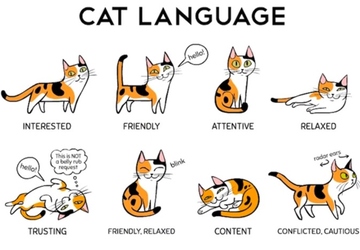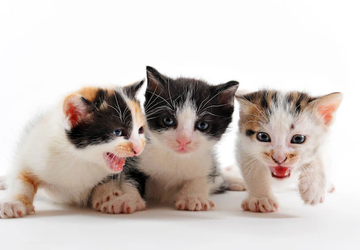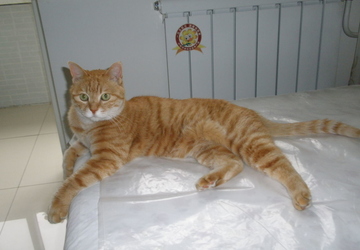Are you satisfied with your cat's level of happiness? Does your cat reciprocate your affection? What are some things your cat enjoys? What type of environment does your cat prefer?
The answer to these questions lies in understanding your cat's behavior. To learn more about your cat, you must know the medium of communication your cat has. Knowing about the unique way of communicating with cats is essential.
For a strong bond with your feline friend, this article will highlight the top 10 signals cats use to communicate with their owners, enabling you to identify and decipher your cats’ cues.
Tail Language

Cats use their tail to express themselves a lot. Understanding tail language will help you better comprehend your cat’s needs and requirements. Different tail gestures include upright, swishing, curled, twitching, puffed-up, and tucked tails.
· Curved tails represent openness and approachability, while upright tails represent assurance and tranquillity.
· Twitching denotes strong focus or excitement, whereas tucked tails imply fear or worry.
· Swishing implies relaxation or anticipation, and puffed-up tails imply anger or terror.
Understanding this essential way of expression will help you establish a cozy atmosphere to improve bonding and communication.
Kneading and Paddling
Kneading and paddling are common cat behaviors that convey affection. Kneading involves pushing the cat's front paws against a soft surface. It is associated with feelings of comfort, relaxation, and contentment and is often seen as a sign of a cat's safety.
Paddling involves both front and back paws moving in a rhythmic motion, often accompanied by purring. Both behaviors are positive displays of affection and bonding.
Ear Position and Movement
Cats show their emotions through their ear position and movement. Observing and understanding a cat’s ear position and movements can decipher valuable insights into its mood and intentions.
A communication tool for cats, key ear signals include forward and slightly tilted ears, constant ear twitching, flattened ears, and one ear forward, one ear back.
To indicate discomfort, cats show flattened ears. Similarly, relaxed ears indicate comfort and curiosity. Including other body language signals in conjunction with the ear and responding accordingly to movements can deepen your connection and promote a harmonious relationship.
Vocalizations
Vocalization is a vital way of communication your cat may use to communicate their emotions, needs, and desires. Common vocalizations include meowing, trilling, purring, growling, hissing, chirping, and howling.
· Meowing is a versatile vocalization that can signify various things.
· Contentment and relaxation are characterized by cats purring.
· Defensive vocalizations of cats are growling and hissing that indicate aggression or fear.
· Yowling or howling is a loud and prolonged vocalization that expresses distress, discomfort, or frustration.
· Silence can also be a form of communication, indicating illness or stress.
Each cat has a unique vocal repertoire, so it is crucial to pay attention to their patterns and context when interpreting their vocalizations.
Body Posture

Cats communicate through their body posture, which can provide insights into their mood and intentions. Critical body posture signals to interpret a cat's behavior include loose, relaxed, arched back, crouching or low to the ground, rolled over, and tense and stiff body.
These signals help you understand your cat's emotional state and respond appropriately. Observing your cat’s body posture can create a safe and comfortable environment. Tailor your interactions to their needs, and build a stronger bond with your feline companion.
Purring
Purring is a distinctive behavior cats exhibit, often associated with contentment and relaxation. It conveys various emotions, such as seeking attention-the lovable quality of cats- and serves various purposes. According to observations and studies, cats purr when they feel content and relaxed. However, not all purring indicates happiness or contentment.
If signs of distress accompany your cat's purring, it's advisable to consult a veterinarian. Understanding the context and body language signals can provide a clearer understanding of their emotional state. Respond positively to their purring, such as providing affection or addressing their needs to strengthen your bond.
Eye Expressions
Eye expressions are also crucial for understanding a cat's behavior and emotions. Some key eye expressions include relaxed and half-closed eyes, dilated or constricted pupils, staring or direct eye contact, and slow blinking.
· Constricted pupils suggest defensive or aggressive states.
· Relaxed eyes indicate contentment and relaxation.
· Dilated pupils indicate excitement, curiosity, or arousal.
· Staring or direct eye contact indicates trust and affection.
· Slow blinking, also known as a "cat kiss," is a friendly gesture, and reciprocating by blinking reinforces the bond.
Biting and Scratching
Biting and scratching are natural behaviors in cats, but understanding their reasons and addressing them is essential. Playful biting and scratching are standard, while overstimulation and fear or aggression can be defensive responses.
To address these behaviors, use positive reinforcement techniques and avoid rough play. Immediately stop the interaction if your cat bites or scratches during play. Consulting an animal behaviorist is helpful if biting or scratching behaviors persist or escalate.
Hissing and Growling
Cats exhibit hissing and growling when feeling threatened, scared, or agitated. Hissing is a sharp, high-pitched sound, while growling is a low, rumbling sound produced when threatened or challenged. These defensive behaviors serve as a warning to potential threats or to establish boundaries.
To address the situation, give your cat space, assess the situation, and create a calming environment. Remember that these behaviors are defensive and should not be punished, as punishment can exacerbate their fear. Patience, understanding, and a safe environment are crucial to helping your cat feel secure and reducing their defensive responses over time.
Grooming Behavior
Grooming behavior in cats involves self-grooming, social bonding, stress reduction, attention-seeking behavior, and behavioral concerns. Cats are meticulous self-groomers, cleaning their fur using their tongue and teeth.
Excessive grooming can cause hair loss, skin irritation, or bald patches. However, it's essential to consult a veterinarian if observing excessive grooming. To support grooming behavior, provide a clean environment and brush fur regularly.
Conclusion
In conclusion, understanding your cat's behavior is essential for building a strong and harmonious bond with your feline companion. You can gain valuable insights into their needs, emotions, and well-being by recognizing and interpreting their signals.
Investing time and effort into understanding your cat's behavior will be reciprocated to you with a solid bond, improved communication, and a happier and healthier cat.















